|
ARTWORKS
& INVENTIONS
|
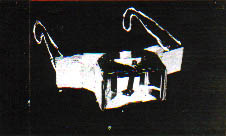 |
* MIRROR
GLASSES These glasses have prisms for lenses, giving the wearer the impression that they have stepped 'through the looking glass' into a mirror world.I think these glasses challenge the idea of seperating things into the categories of being either 'real' or 'representational'. |
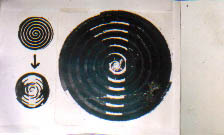 |
*
SPIRAL ANIMATION I developed a spiral version of what is known as the 'picket fence' effect. A spiral printed on transparent acetate fits over a disc encoded with three different images turning the spiral. Reveals one image at a time, by masking the two others. It's like a record (with different tracks) that expresses itself as a surface rather than as a single linear strand (of music). I thought that it might make an interesting kind of clockface, with a big spiral to tell you what quarter of a regular clock face you were in, and a second smaller faster moving spiral to tell you what hour it was in that quarter. (eg a big 4 and a small 3 would be 11 o'clock. |
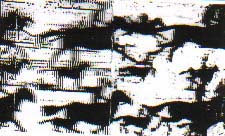 |
*
3-D PHOTOCOPYING By putting a piece of lenticular plastic (ridged transparent plastic) face down on a photocopier and photocopying objects through it, the photocopy that results can be 'decoded' as a 3-D image when viewed back through the lenticular screen. I used this discovery to make a picture book called "A Bandwidth on your Wavelength". |
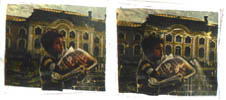 |
* STEROGRAPHIC
COLLAGES If you have two copies of a magazine like National Geographic you can make two sets of separate foreground and background pictures and arrange them to create a stereoscopic effect. Viewable by crossing your eyes. |
 |
* VIRTUAL
REALITY GLASSES These stereoscopic glasses give the illusion of looking around inside a sphere. Each eye looks at one of two identical globes that are in slightly different positions. A handle underneath turns both the globes to give a 360 degree view around the picture. The handle turns in the opposite direction to the globes, in the same way that in real life when you turn your head the view moves in the opposite direction. |
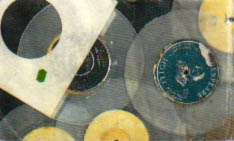 |
* GLUE
RECORDS These are 'reverse' copies of records made using P.V.A. glue and a beer coaster. I poured a layer of glue over the record with the beer coaster covering the middle and peeled it off when it set. I made a lot of 7 inch glue records, but LP (33 rpm) records play better. |
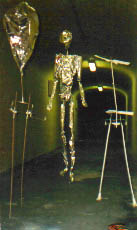 |
* WALKING
ROBOTS One of the hardest things to do in robotics is build a 2-legged robot.These robots use the lifting power provided by helium balloons or propellors to leverage themselved upright. They seem to wander about with a mind of their own. On the far right is a 'Hurricane robot'. Made out of metal, its feet are heavy so it will stay upright. Its counter rotating propellors provide both lift and power to drive its legs. It might walk only a few steps a year, but last for thousands of years. |
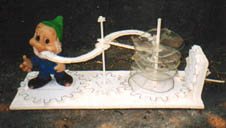 |
* REPLICATOR This machine works by using a pivoting arm to record the contours of an object onto a screw-shaped spiral. Cranking the handle rotates both the scre-shaped spiral and object. One part of the pivotting arm is connected to the screw axis so that it follows the thread from the top to the bottom, recording the object as it goes. Because this process reduces the object to one linear strand of information. The arm could be fitted with a kind of slide-whistle, and the signal transmitted over the telephone. |
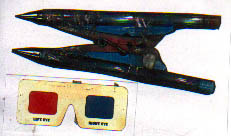 |
* 3-D
DRAWING MACHINE This machine enables the user to create free-hand 3-dimensional drawings and view them in 3-D as they create them, wearing red and blue cellophane glasses. It is made out of a red and blue pen attatched to a clothes line peg. It can be gripped like a regular pen, and the spring in the peg means you can control the distance between the 2 pen tips, as you draw, to change the depth of the line you are drawing. |
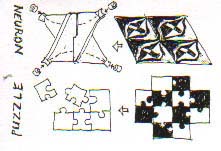 |
* SELF
REPLICATING MACHINES These are machines created from a template which contains both the plans of its components and the components themselves. Using special air-drying modelling clay to create them means that they can be reproduced from the same material and are ready to use once dry. The 'neuron' is a template which produces neuron like units with channels cut into their interior surfaces, that can store or transport ball bearings, capable of interlocking with other units forming a primitive brain-like structure. |
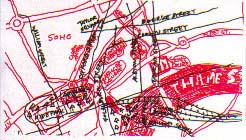 |
*
MAGICAL MYSTERY MAPS If you hold this map of London up to the light, you can see the map of Sydney (printed in reverse on the other side) superimposed underneath it. This allows you to take a virtual tour of London while walking around the city of Sydney. |
|
email: mechanickinetica@hotmail.com |